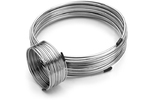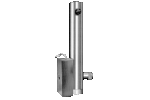- ▶
- Heaters/Source
- ▶
- Agilent Heaters and SensorsMass Spectrometry, Scientific Supplies & ManufacturingScientific Instrument Services 5973 Source Heater Tamper Resistant Allen Wrench 5973/5975 Quad Sensor 5985 Source Heater Assembly Agilent Interface Heater Assembly 5971 Interface Heater

- ▶
- Reference Material on InstrumentationArticle - A High Temperature Direct Probe for a Mass Spectrometer Design of a Direct Exposure Probe and Controller for use ona Hewlett-Packard 5989 Mass Spectrometer SIS AP1000 AutoProbe™ SIS AP2000 AutoProbe™ - Description of System HPP7: Direct Probe Electronics Console HPP7: Direct Probe for the Agilent (HP) 5973/5975 MSD HPP7: HP Direct Probe Application Notes HPP7: Installation Directions for the Direct Probe HPP7: Side Cover for the HP 5973 MSD HPP7: Support HPP7: Probe Inlet System for the Agilent (HP) 5973 and 5975 MSD with Automatic Indexed Stops HPP7: Theory of Operation of the Direct Probe and Probe Inlet System Direct Thermal Extraction Thermal Desorption Application Notes Environmental Thermal Desorption Application Notes Food Science Thermal Desorption Application Notes Forensic Thermal Desorption Application Notes GC Cryo-Trap Application Notes Headspace Application Notes Purge & Trap Thermal Desorption Application Notes Theory of Operation of the AutoDesorb® System AutoDesorb Notes for SIS Dealers Adsorbent Resin Application Notes Installation of the Short Path Thermal Desorption System on Agilent (HP) and Other GCs Installation of the Short Path Thermal Desorption System on a Varian 3400 GC AutoDesorb® System Development Team Thermal Desorption Applications and Reference Materials Installation of the Short Path Thermal Desorption System - TD5 Part I - Design & Operation of the Short Path ThermalDesorption System Installation Instructions for the Model 951 GC Cryo-Trap on the HP 5890 Series GC Installation Instructions for the Model 961 GC Cryo-Trap on the HP 5890 Series GC Operation of the Model 951/961 GC Cryo-Trap SIS GC Cryo Traps - Theory of Operation NIST/EPA/NIH Mass Spectral Enhancements - 1998 version (NIST98) SIMION 3D Ion Optics Class Mass Spectrometer Source Cleaning Methods MS Tip: Mass Spectrometer Source Cleaning Procedures Mass Spec Source Cleaning Procedures Micro-Mesh® Abrasive Sheets Research Papers Using New Era Syringe Pump Systems EI Positive Ion Spectra for Perfluorokerosene (PFK) Cap Liner Information How do I convert between fluid oz and milliliters? Which bottle material should I choose? Which bottle mouth should I choose? The Bottle Selection Guide CGA Connections for Gas Tanks Chemical Reaction Interface Mass Spectrometry (CRIMS)

- Instrument Tubing
- ▶
- Gas RegulatorsModel 3530 Series - Single Stage Purity Brass Regulator Model 3510 Series - Single Stage High Purity Stainless Steel Regulators Model 3120 Series - Dual Stage Purity Brass Regulator Model 3810 Series - Dual Stage High Purity Stainless Steel Regulators Tescom Gas Line Regulators 3420 Series Tescom Gas Line Regulators 3450 Series Concoa In-Line Regulators Model 304 Series Concoa In-Line Regulators Model 324 Series
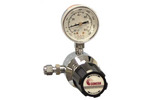
- TD
- GCColumns Fused Silica Tubing Instrument Tubing Injection Port Liners Septa by Manufacturer SIS GC Cryo-Traps Ferrules Valves Swagelok® Fittings Pyrolysis Probe Accessories Gas Generators Gas Regulators Gas Purifiers and Filters Syringes SGE MEPS™-Micro Extraction by Packed Sorbent Purge and Trap System SGE SilFlow™ Stainless Steel Micro-Fluidic Platform Accessories NIST GC RI Library Other GC Supplies Catalog Page D1

- ▶
- GC Cryo-traps
- LiteratureApplication Notes Adsorbent Resins Guide Mass Spec Tips SDS Sheets FAQ MS Calibration Compound Spectra Manuals MS Links/Labs/ Organizations MS Online Tools Flyers on Products/Services Scientific Supplies Catalog About Us NextAdvance Bullet Blender® Homogenizer Protocols Micro-Mesh® Literature Instrumentation Literature Agilent GC/MS Literature SIS News / E-Mail Newsletter NIST MS Database - Update Notifications

- ▶
- Purge & Trap Thermal Desorption Application NotesNote 97: Flavor Profiles of Imported and Domestic Beers by Purge & Trap Thermal Desorption GC/MS Note 93: Detection of Benzene in Carbonated Beverages with Purge & Trap Thermal Desorption GC/MS Note 43: Volatile Organic Composition In Blueberries Note 42: The Influence of Pump Oil Purity on Roughing Pumps Note 38: A New Micro Cryo-Trap For Trapping Of Volatiles At the Front Of a GC Capillary Column Note 35: Volatile Organics Composition of Cranberries Note 34: Selection Of Thermal Desorption and Cryo-Trap Parameters In the Analysis Of Teas Note 33: Changes in Volatile Organic Composition in Milk Over Time Note 32: Selection and Use of Adsorbent Resins for Purge and Trap Thermal Desorption Applications Note 31: Volatile Organic Composition in Several Cultivars of Peaches Note 30: Comparison Of Cooking Oils By Direct Thermal Extraction and Purge and Trap GC/MS Note 26: Volatile Organics Present in Recycled Air Aboard a Commercial Airliner Note 25: Flavor and Aroma in Natural Bee Honey Note 23: Frangrance Qualities in Colognes Note 22: Comparison Of Volatile Compounds In Latex Paints Note 21: Detection and Identification Of Volatile and Semi-Volatile Organics In Synthetic Polymers Used In Food and Pharmaceutical Packaging Note 20: Using Direct Thermal Desorption to Assess the Potential Pool of Styrene and 4-Phenylcyclohexene In Latex-Backed Carpets Note 18: Determination of Volatile Organic Compounds In Mushrooms Note 17: Identification of Volatile Organics in Wines Over Time Note 16: Analysis of Indoor Air and Sources of Indoor Air Contamination by Thermal Desorption Note 14: Identification of Volatiles and Semi-Volatiles In Carbonated Colas Note 8: Detection of Volatile Organic Compounds In Liquids Utilizing the Short Path Thermal Desorption System Note 3: Indoor Air Pollution Note 2: Detection of Arson Accelerants Using Dynamic Headspace with Tenax® Cartridges Thermal Desorption and Cryofocusing

- Application NotesNote 103: EPA Method 325B, Novel Thermal Desorption Instrument Modification to Improve Sensitivity Note 102: Identification of Contaminants in Powdered Beverages by Direct Extraction Thermal Desorption GC/MS Note 101: Identification of Contaminants in Powdered Foods by Direct Extraction Thermal Desorption GC/MS Note 100: Volatile and Semi-Volatile Profile Comparison of Whole Versus Cracked Versus Dry Homogenized Barley Grains by Direct Thermal Extraction Note 99: Volatile and Semi-Volatile Profile Comparison of Whole vs. Dry Homogenized Wheat, Rye and Barley Grains by Direct Thermal Extraction GC/MS Note 98: Flavor and Aroma Profiles of Truffle Oils by Thermal Desorption GC/MS Note 97: Flavor Profiles of Imported and Domestic Beers by Purge & Trap Thermal Desorption GC/MS Note 96: Reducing Warping in Mass Spectrometer Filaments, with SISAlloy® Yttria/Rhenium Filaments Note 95: Detection of Explosives on Clothing Material by Direct and AirSampling Thermal Desorption GC/MS Note 94: Detection of Nepetalactone in the Nepeta Cataria Plant by Thermal Desorption GC/MS Note 93: Detection of Benzene in Carbonated Beverages with Purge & Trap Thermal Desorption GC/MS Note 92: Yttria Coated Mass Spectrometer Filaments Note 91: AutoProbe DEP Probe Tip Temperatures Note 90: An Automated MS Direct Probe for use in an Open Access Environment Note 89: Quantitation of Organics via a Mass Spectrometer Automated Direct Probe Note 88: Analysis of Silicone Contaminants on Electronic Components by Thermal Desorption GC-MS Note 87: Design and Development of an Automated Direct Probe for a Mass Spectrometer Note 86: Simulation of a Unique Cylindrical Quadrupole Mass Analyzer Using SIMION 7.0. Note 85: Replacing an Electron Multiplier in the Agilent (HP) 5973 MSD Note 84: Vacuum Pump Exhaust Filters - Charcoal Exhaust Traps Note 83: Vacuum Pump Exhaust Filters - Oil Mist Eliminators Note 82: Vacuum Pump Exhaust Filters Note 81: Rapid Bacterial Chemotaxonomy By DirectProbe/MSD Note 80: Design, Development and Testing of a Microprocessor ControlledAutomated Short Path Thermal Desorption Apparatus Note 79: Volatile Organic Compounds From Electron Beam Cured and Partially Electron Beam Cured Packaging Using Automated Short Path Thermal Desorption Note 78: A New Solution to Eliminate MS Down-Time With No-Tool-Changing of Analytical GC Columns Note 77: The Determination of Volatile Organic Compounds in VacuumSystem Components Note 76: Determination of the Sensitivity of a CRIMS System Note 75: An Apparatus for Sampling Volatile Organics From LivePlant Material Using Short Path Thermal Desorption Note 74: Examination of Source Design in Electrospray-TOF Using SIMION 3D Note 73: The Analysis of Perfumes and their Effect on Indoor Air Pollution Note 72: 1998 Version of the NIST/EPA/NIH Mass Spectral Library, NIST98 Note 71: Flavor Profile Determination of Rice Samples Using Shor tPath Thermal Desorption GC Methods Note 70: Application of SIMION 6.0 To a Study of the Finkelstein Ion Source: Part II Note 69: Application of SIMION 6.0 To a Study of the Finkelstein Ion Source: Part 1 Note 68: Use of a PC Plug-In UV-Vis Spectrometer To Monitor the Plasma Conditions In GC-CRIMS Note 67: Using Chemical Reaction Interface Mass Spectrometry (CRIMS) To Monitor Bacterial Transport In In Situ Bioremediation Note 66: Probe Tip Design For the Optimization of Direct Insertion Probe Performance Note 65: Determination of Ethylene by Adsorbent Trapping and Thermal Desorption - Gas Chromatography Note 64: Comparison of Various GC/MS Techniques For the Analysis of Black Pepper (Piper Nigrum) Note 63: Determination of Volatile and Semi-Volatile Organics in Printer Toners Using Thermal Desorption GC Techniques Note 62: Analysis of Polymer Samples Using a Direct Insertion Probe and EI Ionization Note 61: Analysis of Sugars Via a New DEP Probe Tip For Use With theDirect Probe On the HP5973 MSD Note 60: Programmable Temperature Ramping of Samples Analyzed ViaDirect Thermal Extraction GC/MS Note 59: Computer Modeling of a TOF Reflectron With Gridless Reflector Using SIMION 3D Note 58: Direct Probe Analysis and Identification of Multicomponent Pharmaceutical Samples via Electron Impact MS Note 57: Aroma Profiles of Lavandula species Note 56: Mass Spec Maintenance & Cleaning Utilizing Micro-Mesh® Abrasive Sheets Note 55: Seasonal Variation in Flower Volatiles Note 54: Identification of Volatile Organic Compounds in Office Products Note 53: SIMION 3D v6.0 Ion Optics Simulation Software Note 52: Computer Modeling of Ion Optics in Time-of-Flight mass Spectrometry Using SIMION 3D Note 51: Development and Characterization of a New Chemical Reaction Interface for the Detection of Nonradioisotopically Labeled Analytes Using Mass Spectrometry (CRIMS) Note 50: The Analysis of Multiple Component Drug Samples Using a Direct Probe Interfaced to the HP 5973 MSD Note 49: Analysis of Cocaine Utilizing a New Direct Insertion Probe on a Hewlett Packard 5973 MSD Note 48: Demonstration of Sensitivity Levels For the Detection of Caffeine Using a New Direct Probe and Inlet for the HP 5973 MSD Note 47: The Application Of SIMION 6.0 To Problems In Time-of-Flight Mass Spectrometry Note 46: Delayed Extraction and Laser Desorption: Time-lag Focusing and Beyond Note 45: Application of SIMION 6.0 to Filament Design for Mass Spectrometer Ionization Sources Note 44: The Design Of a New Direct Probe Inlet For a Mass Spectrometer Note 43: Volatile Organic Composition In Blueberries Note 42: The Influence of Pump Oil Purity on Roughing Pumps Note 41: Hydrocarbon Production in Pine by Direct Thermal Extraction Note 40: Comparison of Septa by Direct Thermal Extraction Note 39: Comparison of Sensitivity Of Headspace GC, Purge and Trap Thermal Desorption and Direct Thermal Extraction Techniques For Volatile Organics Note 38: A New Micro Cryo-Trap For Trapping Of Volatiles At the Front Of a GC Capillary Column Note 37: Volatile Organic Emissions from Automobile Tires Note 36: Identification Of Volatile Organic Compounds In a New Automobile Note 35: Volatile Organics Composition of Cranberries Note 34: Selection Of Thermal Desorption and Cryo-Trap Parameters In the Analysis Of Teas Note 33: Changes in Volatile Organic Composition in Milk Over Time Note 32: Selection and Use of Adsorbent Resins for Purge and Trap Thermal Desorption Applications Note 31: Volatile Organic Composition in Several Cultivars of Peaches Note 30: Comparison Of Cooking Oils By Direct Thermal Extraction and Purge and Trap GC/MS Note 29: Analysis Of Volatile Organics In Oil Base Paints By Automated Headspace Sampling and GC Cryo-Focusing Note 28: Analysis Of Volatile Organics In Latex Paints By Automated Headspace Sampling and GC Cryo-Focusing Note 27: Analysis of Volatile Organics In Soils By Automated Headspace GC Note 26: Volatile Organics Present in Recycled Air Aboard a Commercial Airliner Note 25: Flavor and Aroma in Natural Bee Honey Note 24: Selection of GC Guard Columns For Use With the GC Cryo-Trap Note 23: Frangrance Qualities in Colognes Note 22: Comparison Of Volatile Compounds In Latex Paints Note 21: Detection and Identification Of Volatile and Semi-Volatile Organics In Synthetic Polymers Used In Food and Pharmaceutical Packaging Note 20: Using Direct Thermal Desorption to Assess the Potential Pool of Styrene and 4-Phenylcyclohexene In Latex-Backed Carpets Note 19: A New Programmable Cryo-Cooling/Heating Trap for the Cryo-Focusing of Volatiles and Semi-Volatiles at the Head of GC Capillary Columns Note 18: Determination of Volatile Organic Compounds In Mushrooms Note 17: Identification of Volatile Organics in Wines Over Time Note 16: Analysis of Indoor Air and Sources of Indoor Air Contamination by Thermal Desorption Note 14: Identification of Volatiles and Semi-Volatiles In Carbonated Colas Note 13: Identification and Quantification of Semi-Volatiles In Soil Using Direct Thermal Desorption Note 12: Identification of the Volatile and Semi-Volatile Organics In Chewing Gums By Direct Thermal Desorption Note 11: Flavor/Fragrance Profiles of Instant and Ground Coffees By Short Path Thermal Desorption Note 10: Quantification of Naphthalene In a Contaminated Pharmaceutical Product By Short Path Thermal Desorption Note 9: Methodologies For the Quantification Of Purge and Trap Thermal Desorption and Direct Thermal Desorption Analyses Note 8: Detection of Volatile Organic Compounds In Liquids Utilizing the Short Path Thermal Desorption System Note 7: Chemical Residue Analysis of Pharmaceuticals Using The Short Path Thermal Desorption System Note 6: Direct Thermal Analysis of Plastic Food Wraps Using the Short Path Thermal Desorption System Note 5: Direct Thermal Analysis Using the Short Path Thermal Desorption System Note 4: Direct Analysis of Spices and Coffee Note 3: Indoor Air Pollution Note 2: Detection of Arson Accelerants Using Dynamic Headspace with Tenax® Cartridges Thermal Desorption and Cryofocusing Note 1: Determination of Off-Odors and Other Volatile Organics In Food Packaging Films By Direct Thermal Analysis-GC-MS Tech No. "A" Note 14: Elimination of "Memory" Peaks in Thermal Desorption Improving Sensitivity in the H.P. 5971 MSD and Other Mass Spectrometers - Part I of II Improving Sensitivity in the H.P. 5971 MSD and Other Mass Spectrometers- Part II of II Adsorbent Resins Guide Development and Field Tests of an Automated Pyrolysis Insert for Gas Chromatography. Hydrocarbon Production in Pine by Direct Thermal Extraction A New Micro Cryo-Trap for the Trapping of Volatiles at the Front of a GC Capillary (019P) - Comparison of Septa by Direct Thermal Extraction Volatile Organic Composition in Blueberry Identification of Volatile Organic Compounds in Office Products Detection and Indentification of Volatiles in Oil Base Paintsby Headspace GC with On Column Cryo-Trapping Evaluation of Septa Using a Direct Thermal Extraction Technique INFLUENCE OF STORAGE ON BLUEBERRY VOLATILES Selection of Thermal Desorption and Cryo-Trap Parameters in the Analysis of Teas Redesign and Performance of a Diffusion Based Solvent Removal Interface for LC/MS The Design of a New Direct Probe Inlet for a Mass Spectrometer Analytes Using Mass Spectrometry (CRIMS) Application of SIMION 6.0 to Filament Design for Mass Spectrometer Ionization Sources A Student Guide for SIMION Modeling Software Application of SIMION 6.0 to Problems in Time-of-flight Mass Spectrometry Comparison of Sensitivity of Headspace GC, Purge and TrapThermal Desorption and Direct Thermal Extraction Techniques forVolatile Organics The Influence of Pump Oil Purity on Roughing Pumps Analysis of Motor Oils Using Thermal Desorption-Gas Chromatography-Mass Spectrometry IDENTIFICATION OF VOLATILE ORGANIC COMPOUNDS IN PAPER PRODUCTS Computer Modeling of Ion Optics in Time-of-Flight mass Spectrometry using SIMION 3D Seasonal Variation in Flower Volatiles Development of and Automated Microprocessor Controlled Gas chromatograph Fraction Collector / Olfactometer Delayed Extraction and Laser Desorption: Time-lag Focusing and Beyond A New Micro Cryo-Trap for the Trapping of Volatiles at the Front of a GC Column Design of a Microprocessor Controlled Short Path Thermal Desorption Autosampler Computer Modeling of Ion Optics in Time-of-Flight Mass Spectrometry Using SIMION 3D Thermal Desorption Instrumentation for Characterization of Odors and Flavors

- AccessoriesTD Supply Kit Desorption Tubes Adsorbent Resins Desorption Tube Needles Desorption Tube Seals Desorption System Fittings GC Cryo-Trap Extraction Cell TD Sample Loader Prepacked, Conditioned Desorption Tubes Desorption Tube Packing Accessories Stainless Steel Purge Heads Injection Port Liners Tenax TA Poster TD Application Notes Customer Service

- ▶
- GC Cryo-Trap Application NotesNote 43: Volatile Organic Composition In Blueberries Note 42: The Influence of Pump Oil Purity on Roughing Pumps Note 41: Hydrocarbon Production in Pine by Direct Thermal Extraction Note 40: Comparison of Septa by Direct Thermal Extraction Note 39: Comparison of Sensitivity Of Headspace GC, Purge and Trap Thermal Desorption and Direct Thermal Extraction Techniques For Volatile Organics Note 38: A New Micro Cryo-Trap For Trapping Of Volatiles At the Front Of a GC Capillary Column Note 37: Volatile Organic Emissions from Automobile Tires Note 36: Identification Of Volatile Organic Compounds In a New Automobile Note 34: Selection Of Thermal Desorption and Cryo-Trap Parameters In the Analysis Of Teas Note 31: Volatile Organic Composition in Several Cultivars of Peaches Note 30: Comparison Of Cooking Oils By Direct Thermal Extraction and Purge and Trap GC/MS Note 29: Analysis Of Volatile Organics In Oil Base Paints By Automated Headspace Sampling and GC Cryo-Focusing Note 28: Analysis Of Volatile Organics In Latex Paints By Automated Headspace Sampling and GC Cryo-Focusing Note 27: Analysis of Volatile Organics In Soils By Automated Headspace GC Note 24: Selection of GC Guard Columns For Use With the GC Cryo-Trap Note 19: A New Programmable Cryo-Cooling/Heating Trap for the Cryo-Focusing of Volatiles and Semi-Volatiles at the Head of GC Capillary Columns

- Forensic Thermal Desorption Application NotesNote 95: Detection of Explosives on Clothing Material by Direct and AirSampling Thermal Desorption GC/MS Note 42: The Influence of Pump Oil Purity on Roughing Pumps Note 41: Hydrocarbon Production in Pine by Direct Thermal Extraction Note 40: Comparison of Septa by Direct Thermal Extraction Note 39: Comparison of Sensitivity Of Headspace GC, Purge and Trap Thermal Desorption and Direct Thermal Extraction Techniques For Volatile Organics Note 37: Volatile Organic Emissions from Automobile Tires Note 29: Analysis Of Volatile Organics In Oil Base Paints By Automated Headspace Sampling and GC Cryo-Focusing Note 28: Analysis Of Volatile Organics In Latex Paints By Automated Headspace Sampling and GC Cryo-Focusing Note 27: Analysis of Volatile Organics In Soils By Automated Headspace GC Note 23: Frangrance Qualities in Colognes Note 22: Comparison Of Volatile Compounds In Latex Paints Note 21: Detection and Identification Of Volatile and Semi-Volatile Organics In Synthetic Polymers Used In Food and Pharmaceutical Packaging Note 20: Using Direct Thermal Desorption to Assess the Potential Pool of Styrene and 4-Phenylcyclohexene In Latex-Backed Carpets Note 7: Chemical Residue Analysis of Pharmaceuticals Using The Short Path Thermal Desorption System Note 6: Direct Thermal Analysis of Plastic Food Wraps Using the Short Path Thermal Desorption System Note 5: Direct Thermal Analysis Using the Short Path Thermal Desorption System Note 3: Indoor Air Pollution Note 2: Detection of Arson Accelerants Using Dynamic Headspace with Tenax® Cartridges Thermal Desorption and Cryofocusing Note 1: Determination of Off-Odors and Other Volatile Organics In Food Packaging Films By Direct Thermal Analysis-GC-MS

- Thermal Desorption Applications and Reference MaterialsDirect Thermal Extraction Headspace Environmental Food Science Applications Pharmaceuticals Forensic Note 103: EPA Method 325B, Novel Thermal Desorption Instrument Modification to Improve Sensitivity Note 102: Identification of Contaminants in Powdered Beverages by Direct Extraction Thermal Desorption GC/MS Note 101: Identification of Contaminants in Powdered Foods by Direct Extraction Thermal Desorption GC/MS Note 100: Volatile and Semi-Volatile Profile Comparison of Whole Versus Cracked Versus Dry Homogenized Barley Grains by Direct Thermal Extraction Note 99: Volatile and Semi-Volatile Profile Comparison of Whole vs. Dry Homogenized Wheat, Rye and Barley Grains by Direct Thermal Extraction GC/MS Note 98: Flavor and Aroma Profiles of Truffle Oils by Thermal Desorption GC/MS Note 97: Flavor Profiles of Imported and Domestic Beers by Purge & Trap Thermal Desorption GC/MS Note 95: Detection of Explosives on Clothing Material by Direct and AirSampling Thermal Desorption GC/MS Note 94: Detection of Nepetalactone in the Nepeta Cataria Plant by Thermal Desorption GC/MS Note 93: Detection of Benzene in Carbonated Beverages with Purge & Trap Thermal Desorption GC/MS Note 88: Analysis of Silicone Contaminants on Electronic Components by Thermal Desorption GC-MS Note 84: Vacuum Pump Exhaust Filters - Charcoal Exhaust Traps Note 83: Vacuum Pump Exhaust Filters - Oil Mist Eliminators Note 82: Vacuum Pump Exhaust Filters Note 80: Design, Development and Testing of a Microprocessor ControlledAutomated Short Path Thermal Desorption Apparatus Note 79: Volatile Organic Compounds From Electron Beam Cured and Partially Electron Beam Cured Packaging Using Automated Short Path Thermal Desorption Note 77: The Determination of Volatile Organic Compounds in VacuumSystem Components Note 75: An Apparatus for Sampling Volatile Organics From LivePlant Material Using Short Path Thermal Desorption Note 73: The Analysis of Perfumes and their Effect on Indoor Air Pollution Note 71: Flavor Profile Determination of Rice Samples Using Shor tPath Thermal Desorption GC Methods Note 65: Determination of Ethylene by Adsorbent Trapping and Thermal Desorption - Gas Chromatography Note 64: Comparison of Various GC/MS Techniques For the Analysis of Black Pepper (Piper Nigrum) Note 63: Determination of Volatile and Semi-Volatile Organics in Printer Toners Using Thermal Desorption GC Techniques Note 60: Programmable Temperature Ramping of Samples Analyzed ViaDirect Thermal Extraction GC/MS Note 57: Aroma Profiles of Lavandula species Note 55: Seasonal Variation in Flower Volatiles Note 54: Identification of Volatile Organic Compounds in Office Products Note 43: Volatile Organic Composition In Blueberries Note 42: The Influence of Pump Oil Purity on Roughing Pumps Note 41: Hydrocarbon Production in Pine by Direct Thermal Extraction Note 40: Comparison of Septa by Direct Thermal Extraction Note 39: Comparison of Sensitivity Of Headspace GC, Purge and Trap Thermal Desorption and Direct Thermal Extraction Techniques For Volatile Organics Note 38: A New Micro Cryo-Trap For Trapping Of Volatiles At the Front Of a GC Capillary Column Note 37: Volatile Organic Emissions from Automobile Tires Note 36: Identification Of Volatile Organic Compounds In a New Automobile Note 35: Volatile Organics Composition of Cranberries Note 34: Selection Of Thermal Desorption and Cryo-Trap Parameters In the Analysis Of Teas Note 33: Changes in Volatile Organic Composition in Milk Over Time Note 32: Selection and Use of Adsorbent Resins for Purge and Trap Thermal Desorption Applications Note 31: Volatile Organic Composition in Several Cultivars of Peaches Note 30: Comparison Of Cooking Oils By Direct Thermal Extraction and Purge and Trap GC/MS Note 29: Analysis Of Volatile Organics In Oil Base Paints By Automated Headspace Sampling and GC Cryo-Focusing Note 28: Analysis Of Volatile Organics In Latex Paints By Automated Headspace Sampling and GC Cryo-Focusing Note 27: Analysis of Volatile Organics In Soils By Automated Headspace GC Note 26: Volatile Organics Present in Recycled Air Aboard a Commercial Airliner Note 25: Flavor and Aroma in Natural Bee Honey Note 24: Selection of GC Guard Columns For Use With the GC Cryo-Trap Note 23: Frangrance Qualities in Colognes Note 22: Comparison Of Volatile Compounds In Latex Paints Note 21: Detection and Identification Of Volatile and Semi-Volatile Organics In Synthetic Polymers Used In Food and Pharmaceutical Packaging Note 20: Using Direct Thermal Desorption to Assess the Potential Pool of Styrene and 4-Phenylcyclohexene In Latex-Backed Carpets Note 19: A New Programmable Cryo-Cooling/Heating Trap for the Cryo-Focusing of Volatiles and Semi-Volatiles at the Head of GC Capillary Columns Note 18: Determination of Volatile Organic Compounds In Mushrooms Note 17: Identification of Volatile Organics in Wines Over Time Note 16: Analysis of Indoor Air and Sources of Indoor Air Contamination by Thermal Desorption Note 14: Identification of Volatiles and Semi-Volatiles In Carbonated Colas Note 13: Identification and Quantification of Semi-Volatiles In Soil Using Direct Thermal Desorption Note 12: Identification of the Volatile and Semi-Volatile Organics In Chewing Gums By Direct Thermal Desorption Note 11: Flavor/Fragrance Profiles of Instant and Ground Coffees By Short Path Thermal Desorption Note 10: Quantification of Naphthalene In a Contaminated Pharmaceutical Product By Short Path Thermal Desorption Note 9: Methodologies For the Quantification Of Purge and Trap Thermal Desorption and Direct Thermal Desorption Analyses Note 8: Detection of Volatile Organic Compounds In Liquids Utilizing the Short Path Thermal Desorption System Note 7: Chemical Residue Analysis of Pharmaceuticals Using The Short Path Thermal Desorption System Note 6: Direct Thermal Analysis of Plastic Food Wraps Using the Short Path Thermal Desorption System Note 5: Direct Thermal Analysis Using the Short Path Thermal Desorption System Note 4: Direct Analysis of Spices and Coffee Note 3: Indoor Air Pollution Note 2: Detection of Arson Accelerants Using Dynamic Headspace with Tenax® Cartridges Thermal Desorption and Cryofocusing Note 1: Determination of Off-Odors and Other Volatile Organics In Food Packaging Films By Direct Thermal Analysis-GC-MS

- ▶
- Environmental Thermal Desorption Application NotesNote 42: The Influence of Pump Oil Purity on Roughing Pumps Note 41: Hydrocarbon Production in Pine by Direct Thermal Extraction Note 40: Comparison of Septa by Direct Thermal Extraction Note 39: Comparison of Sensitivity Of Headspace GC, Purge and Trap Thermal Desorption and Direct Thermal Extraction Techniques For Volatile Organics Note 38: A New Micro Cryo-Trap For Trapping Of Volatiles At the Front Of a GC Capillary Column Note 37: Volatile Organic Emissions from Automobile Tires Note 36: Identification Of Volatile Organic Compounds In a New Automobile Note 27: Analysis of Volatile Organics In Soils By Automated Headspace GC Note 26: Volatile Organics Present in Recycled Air Aboard a Commercial Airliner Note 16: Analysis of Indoor Air and Sources of Indoor Air Contamination by Thermal Desorption Note 13: Identification and Quantification of Semi-Volatiles In Soil Using Direct Thermal Desorption Note 8: Detection of Volatile Organic Compounds In Liquids Utilizing the Short Path Thermal Desorption System Note 3: Indoor Air Pollution Note 2: Detection of Arson Accelerants Using Dynamic Headspace with Tenax® Cartridges Thermal Desorption and Cryofocusing

- ▶
- Note 42: The Influence of Pump Oil Purity on Roughing Pumps (This Page)
1999
INTRODUCTION
Pump oils contain a wide variety of volatile semi-volatile organics and the breakdown of these compounds can affect the life of a rough pump. This degradation of pump oils and the resulting effect on the life of vacuum rough pumps is a major concern to the users of mass spectrometer and other vacuum system instruments. Analytical techniques are needed to identify and quantitate volatile organic compounds (VOC's) present in oils. These techniques can be used not only to study the breakdown of vacuum pump oils but can also be incorporated into a quality control program to ensure product purity during manufacture. Sensitive techniques are needed to profile and identify VOC's in pump oils so that they can be used to ensure the life of the pump. Headspace GC analysis, cryofocusing techniques, and high-resolution GC have previously been used for the analysis of commercial oils. Static headspace techniques are limited in their detection and identification of the most volatile organic volatiles and have proven to be very insensitive for the less volatile organics as well as the semi-volatile organics.
The purpose of this investigation is to develop an analytical technique that could detect and identify a wide range of volatile and semi-volatile organic compounds in pump oils over time. For this study, volatile organic compounds are purged from oil samples utilizing a dynamic purge and trap technique (P&T) system followed by trapping on a Tenax® TA adsorbent resin trap. The adsorbent traps are ballistically heated and together with the carrier gas flow through the samples the volatiles are desorbed into the GC injection port and onto the front of the GC column for subsequent analysis by gas chromatography-mass spectrometry (TD-GC-MS). The volatile and semi-volatile organics present in the pump oils are quantified using a matrix spiked deuterated internal standard. The P&T technique permits the analysis of a wider range of both volatile and semi-volatile organic compounds and is more sensitive as compared to the static headspace technique.
Instrumentation
Samples were collected using a Scientific Instrument Services Purge and Trap System. This apparatus consists of a sparge gas inlet connected to a stainless steel purging needle that is inserted through an adaptor fitting into the oil sample in the bottom of the 10 ml purge and trap test tube. A dry purge gas inlet is located at a right angle to the sparge gas inlet at the top of the apparatus. The purpose of the dry purge is to reduce the water vapor condensation on the adsorbent trap. Opposite the dry purge inlet is the connector for the desorption tube. A glass-lined stainless steel (GLT) desorption tube containing the adsorbent resin is attached to this fitting for the trapping of the purged volatiles.
All experiments were conducted using a Scientific Instrument Services model TD-3 Short Path Thermal Desorption System accessory connected to the injection port of an HP 5890 Series II GC interfaced to an HP 5971 Mass Selective Detector (MSD). The mass spectrometer was operated in the electron impact mode (EI) and scanned from 35 to 550 daltons during the GC run for the total ion chromatogram.
The HP 5890 Series II GC contained a short 0.5 meter by 0.53 mm diameter fused silica precolumn attached to the injection port end of a J&W 30 meter x 0.25 mm i.d. DB-5MS capillary column containing a 0.25 micron film thickness. The GC injection port was set to 260 degrees C and a 10:1 split was used. The head of the column was maintained at -70 degrees C using an S.I.S. Cryotrap model 951 during the desorption and extraction process and then ballistically heated to 200 degrees C to release the volatiles after which the GC oven was temperature programmed from 35 degrees C (hold for 5 minutes) to 80 degrees C at 10 degrees C/min, then to 200 degrees C at 4 degrees C/min and finally to 260 degrees C at a rate of 10 degrees C/min.
Experimental
Fresh oil samples of Inland 45, Inland 19 and Invoil 20 pump oils were collected on January 20, 1996, followed by monthly collections of Inland 45 and Inland 19 pump oils from two continuously running Alcatel model UM2012 vacuum pumps. Monthly oil samples were taken for a period of 3 months on February 20, 1996, March 19, 1996 and April 16, 1996 and subsequently analyzed to determine the presence and changes of VOC's over time that would ultimately affect the life of the pump.
Samples from 2 different kinds of pump oil (Inland 45 & Inland 19) were removed from two continuously running Alcatel model UM2012 vacuum pumps over a three month time period and analyzed by a dynamic purge and trap technique to compare and quantitate the volatile organics present. An additional fresh sample of Invoil 20 pump oil was also examined for comparison. These three oils (Inland 19, Invoil 20 and Inland 45) represent the most widely used oils in vacuum pumps on mass spectrometers and related vacuum instruments in the scientific community. For quantification, 100 ng of a deuterated cymene internal standard was spiked into the adsorbent traps after the volatiles from the oil samples had been purged onto the adsorbent resin traps. No correction for extraction efficiency of recovery is achieved using this technique; however, it functions as a useful means to semi-quantitate the volatile and semi-volatile organics purged from the oil samples onto the adsorbent traps.
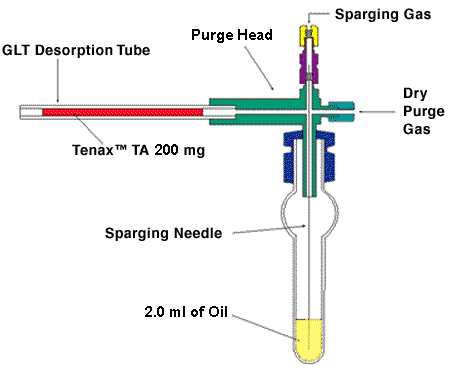
Two ml aliquots of oil were removed monthly from each vacuum pump and transferred into a 10 ml test tube and heated to 60 degrees C for 30 minutes. Samples were sparged with high purity helium at 20 ml/min (600 ml) with an additional 25 ml/min (750 ml) dry purge using an S.I.S. Purge and Trap System. Volatile analytes were gas extracted and carried to a preconditioned 4.0 mm i.d. glass-lined stainless steel desorption tube packed with 200 mg of Tenax TA. Once the samples were collected, they were spiked with 100 ng of d-cymene internal standard by injecting 1 ul of a 100 ng/ul of a d-14 cymene stock solution in methanol by syringe injection into the Tenax matrix, and then purged for an additional 5 minutes at 50 ml/min (250 ml) to remove the methanol. The desorption tube with sample and internal standard was then attached to the Short Path Thermal Desorption System and a syringe needle attached. The desorption tube was injected into the GC injection port at desorption block temperatures of 220 degrees C for 5 minutes at a flow rate of 12 ml per minute. The GC Injection port was maintained at 260 degrees and the GC Cryo-Trap at the front of the GC column was maintained at -70 degrees C during this desorption process. A 10:1 split was used during desorption to avoid overloading the GC capillary column. After desorption was complete, the GC Cryo-Trap was rapidly heated to 220 degrees C to release the volatiles and the GC was temperature programmed as described above. The GC peaks were detected via the HP MSD and identified using the Wiley NBS reference library to confirm the identification of each compound eluted.
Results and Discussion
The three pump oils Inland 19, Invoil 20 and Inland 45 are the most widely used oils for vacuum pumps for mass spectrometers and other scientific vacuum equipment. Inland 19 was the standard pump oil until about 8 years ago, when Invoil 20 was recommended by SIS for this purpose due to is lower vapor pressure and better vacuum capacities for the vacuum rough pumps. More recently Inland 45 has been recommended by both SIS and HP for use in vacuum pumps on mass spectrometers. This oil has an even better vacuum rating than the other two oils and will produce the optimum vacuum levels for mass spectrometers. These three oils are used by the majority of vacuum pump manufacturers (including Alcatel and Edwards) as well as by the majority of mass spectrometer manufacturers.
The first part of this study is to compare the three pump oils to verify why the Inland 45 has proven superior to the Invoil 20 which has proven superior to the Inland 19 vacuum pump oils. The comparison of these oils is shown in Figures 1, 2 and 3. The second part of this study demonstrates the degradation of the Inland 19 and Inland 45 pump oils after 1, 2 and 3 months of continuous use in an Alcatel vacuum pump. The inlet port of the vacuum pump is blanked off to prevent air or other contaminants from entering the vacuum pump. This mimics the continuous use to which these oils would be exposed to in a mass spectrometer system. However, it does not truly demonstrate the actual use in a mass spectrometer during which a large vacuum chamber is pumped and the injection of samples into the vacuum system which eventually are purged into the vacuum pump oil. These conditions would further degrade the pump oils at various rates depending on the instrument environment and the types of analytes injected into the mass spectrometer.
Over 100 volatile organics were identified in each of the oil samples analyzed (Fig 1, 2 and 3). The oil samples studied produced 50 or more volatile organics which were identified in addition to many more that were either too weak to identify or in which a good NBS library match was not achievable. The compounds identified are listed in Table I which also serves as an index to the total ion chromatograms for each of the pump oils analyzed.
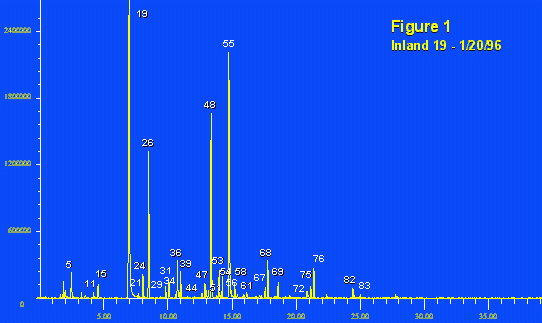
The analysis of fresh Inland 19 pump oil is shown in Fig. 1. It was found to contain several straight chain hydrocarbons from decane through dodecane (peaks 53, 67 and 75) as well as numerous substituted benzenes (peaks 19, 29, 31, 36, 44, 47, 51, 56 and 61), aldehydes from pentanal through decanal (peaks 15, 24, 39, 54, 68 and 76) and ketones (peaks 5, 11, 21, 34, 72, and 82). A high concentration of the aromatic compound toluene (peak 19) was also present. Several siloxanes (peaks 26, 48 and 69) were also detected. Hydrocarbon chains shorter than C10 were not detected. The internal standard d14-cymene is peak 55 in all the chromatograms.
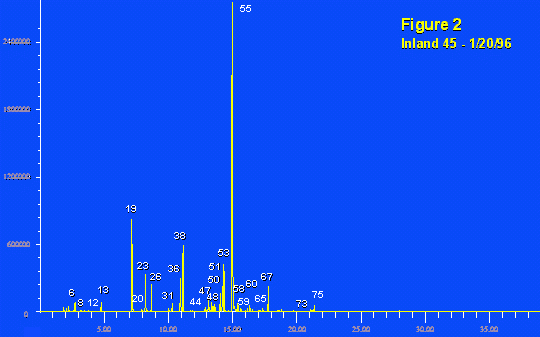
The total ion chromatogram of Inland 45 is shown in Fig. 2. It is quite evident that this sample contains significantly less volatiles than the Inland 19 pump oil shown in Fig 1. This explains the lower vapor pressure for Inland 45 and also the reason that better vacuum levels can be achieved with this oil. A number of hydrocarbons from hexane through dodecane (peaks 6, 13, 23, 38, 53, 67 and 75) were detected as well as a large number of aromatics (peaks 19, 31, 36, 44, 47, 51, 59, 60 and 65). The siloxanes hexamethyl-cyclotrisiloxane, octamethyl-cyclotetrasiloxane and decamethyl-cyclopentasiloxane which are related to cleaning and lubricating compounds were detected in both the fresh Inland 19 and Inland 45 pump oils (Figs. 1&2). Absent from the Inland 45 oil are the aldehydes and ketones which were so prevalent in the Inland 19 oil.
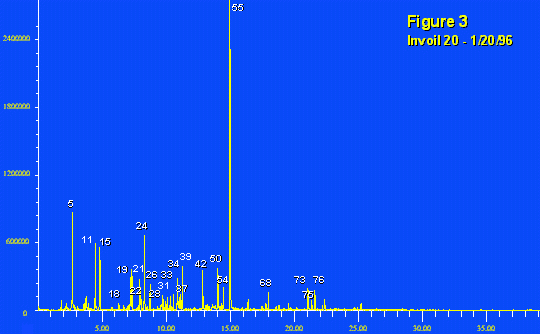
The total ion chromatogram of Invoil 20 is shown in Fig. 3. It is quite evident that this sample contains significantly less volatiles than the Inland 19 pump oil shown in Fig 1. This explains the lower vapor pressure for Inland 45 and also the reason that better vacuum levels can be achieved with this oil. However, the Invoil 20 contained several low boiling aldehydes (peaks 5, 11 and 15) which were not detected in the Inland 45. This demonstrates the advantage of Inland 45 as the optimum pump oil for vacuum systems. The straight chain hydrocarbons were absent from the Invoil 20 oil with the exception of dodecane (peak 75). Only two aromatics compounds toluene and xylene (peaks 19 and 31) were detected; however, a large number of aldehydes from pentanal through decanal (peaks 15, 24, 39, 54, 68 and 76) and ketones (peaks 5, 11, 18, 21, 22, 34, 37 and 42) were identified. Of the siloxanes only hexamethyl-cyclotrisiloxane was detected in Invoil 20.
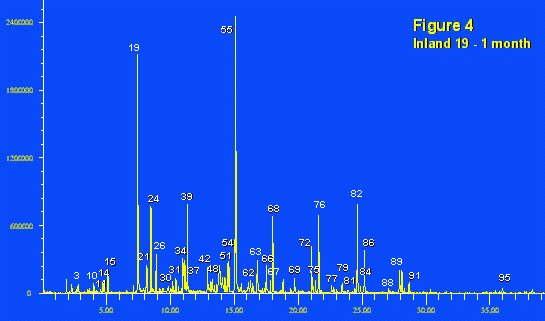
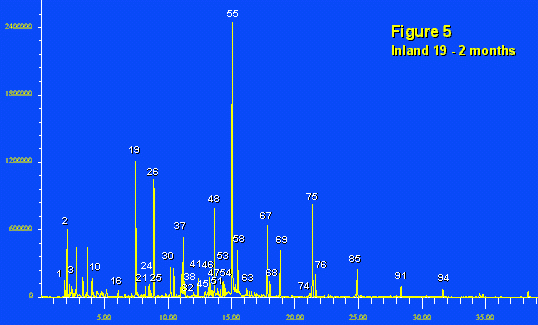
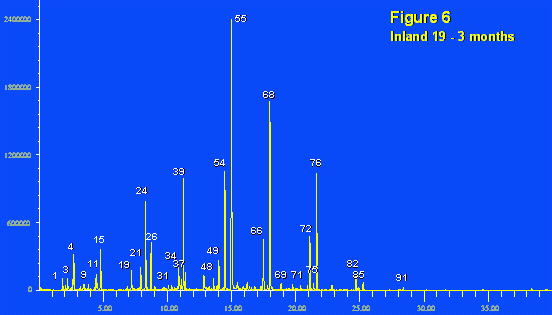
After 1 month, the concentrations of VOC's in the Inland 19 pump oil slightly increased with the exception of the aromatic compound toluene which was significantly reduced with time (Fig. 4). The compounds 5-ethyldihydro-2(3)-furanone (peak 62), dihydro-5-pentyl-2(3H)-furanone (peak 79) and 5-hexyldihydro-2(3H)-furanone (peak 88) were also identified at this time. Generally, the concentrations of VOC's in the Inland 19 pump oil remained approximately the same after 2 months with slight increases in hydrocarbons and siloxanes and continued decrease in the aromatic compound toluene (Fig. 5). After 3 months, there were significant increases in the levels of the aldehydes butanal, pentanal, hexanal, heptanal, octanal, nonanal and decanal (peaks 4, 15, 24, 39, 54, 68 and 76) (Fig. 6) as compared to the 2 month sample of Inland 19 pump oil. The increased concentration of these aldehydes is significant after three months of continued use. These aldehydes can be expected to be converted to acids with continued use of the vacuum pumps. This decrease of pH will contribute to increased vacuum pump wear. This demonstrates the necessity of changing vacuum pump oils after three months of continued use in order to maximize vacuum pump life.
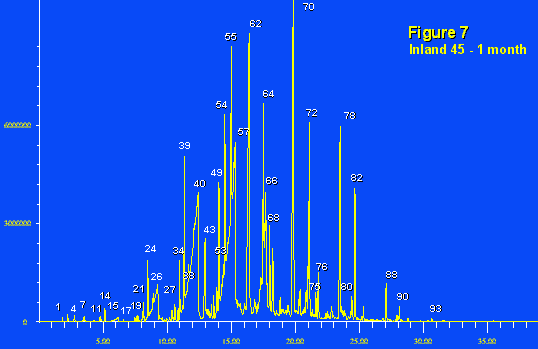
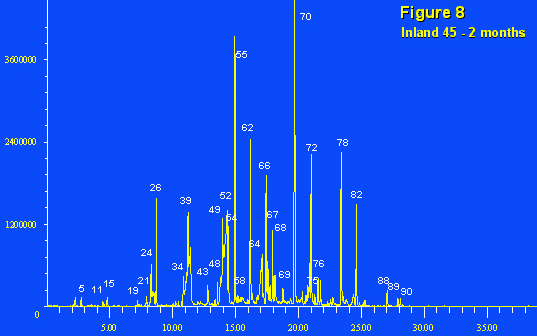
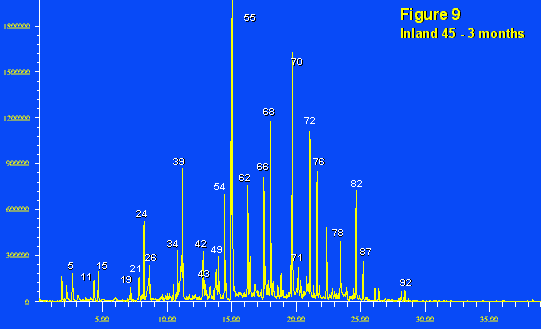
The volatiles in Inland 45 pump oil increased dramatically after only 1 month of continued use (Fig. 7). Inland 45 pump oil exhibited significant increases in the propanoic, butanoic, pentanoic, hexanoic and heptanoic acids (peaks 17, 27, 40, 57 and 64) as well as aldehydes, ketones and furanone derivatives after the initial month. Significant amounts of dihydro-5-methyl-2(3H)-furanone (peak 43), dihydro-5-propyl-2-(3H)-furanone (peak 70) and 5-butyldihydro-2(3H)-furanone (peak 78) were also detected at this time (Fig. 7). After 2 months of continued use, the concentrations of VOC's in the Inland 45 pump oil were significantly reduced with the exception of the siloxanes (Fig. 8). The same decreasing trend continued in the Inland 45 pump oil at 3 months with continued reduction in the concentrations of volatile organics (Fig. 9). It appears that the most significant changes in pump oil occurs after its initial use with gradual changes in pump oil purity after continued use.
Conclusion
The Short Path Thermal Desorption System used in conjunction with a dynamic purge and trap technique permits the identification and quantification of trace levels of volatile organics in pump oils. The method previously described permits both the qualitative and quantitative analysis of pump oils to identify the volatile organics, contaminants and off-odor compounds present. This technique has proven effective in detecting and identifying a larger number of organic compounds at concentrations lower than was previously obtainable via other analysis techniques. It also permits the analysis of a wider range of both volatile and semi-volatile organic compounds and is more sensitive as compared to the static headspace technique. It represents a tremendous improvement over the time-consuming solvent extraction techniques normally used in the laboratory. This technique can be easily incorporated into a troubleshooting technique to detect problems in a wide variety of commercial products, to compare competing manufacturers products, as well as a quality control program.
Inland 45 has been shown to be the optimum pump oil for rough vacuum pumps used in mass spectrometers and other vacuum systems in scientific instruments. It contains the lowest level of volatile organics than either of the two popular vacuum pump oils studied. It also contained low levels of aldehydes and ketones.
Manufactures of vacuum pumps recommend changing pump oils after every 3 months of pump use. The large chain hydrocarbons and other large synthetics present in the oils break down with time producing a large number of lower boiling compounds. These compounds all raise the vapor pressure of the oil thereby reducing its capacity to achieve low vacuum levels. As shown above, aldehydes and ketones are generated from the degradation of vacuum pump oils with continued use. With time, these aldehydes can be converted to acids which will rapidly enhance the wear inside the vacuum pump thereby reducing its life. This confirms the need to change vacuum pump oils on a regular basis.
This study is being continued. The two pumps with the Inland 19 and Invoil 45 are continuing to operate and additional oil samples will be removed and tested to further complete this study.
Index for Figures 1 through 9
- 1.
- 2-propanone
- 2.
- 2-methyl-1,3-butadiene
- 3.
- 1-hexene
- 4.
- butanal
- 5.
- 2-butanone
- 6.
- hexane
- 7.
- acetic acid
- 8.
- 1,3-hexadien-5-yne
- 9.
- 1,5-hexadien-3-yne
- 10.
- benzene
- 11.
- 2-pentanone
- 12.
- 1,2-dimethyl-cyclopentane
- 13.
- heptane
- 14.
- 1-heptene
- 15.
- pentanal
- 16.
- methyl-cyclohexane
- 17.
- propanoic acid
- 18.
- 4-methyl-2-pentanone
- 19.
- toluene
- 20.
- 1-octene
- 21.
- 2-hexanone
- 22.
- cyclopentanone
- 23.
- octane
- 24.
- hexanal
- 25.
- tetrachloro-ethene
- 26.
- hexamethyl-cyclotrisiloxane
- 27.
- butanoic acid
- 28.
- 3-methyl-cyclopentanone
- 29.
- 1,3-dimethyl-benzene
- 30.
- ethyl-benzene
- 31.
- xylene
- 32.
- 1,2-dimethyl-benzene
- 33.
- 4-methyl-hexanal
- 34.
- 2-heptanone
- 35.
- 1,3-dimethyl-benzene
- 36.
- styrene
- 37.
- cyclohexanone
- 38.
- nonane
- 39.
- heptanal
- 40.
- pentanoic acid
- 41.
- alpha-pinene
- 42.
- 6-methyl-2-heptanone
- 43.
- dihydro-5-methyl-2(3H)-furanone
- 44.
- 1-ethyl-2-methyl-benzene
- 45.
- 1-ethyl-4-methyl-benzene
- 46.
- benzaldehyde
- 47.
- 1,3,5-trimethyl-benzene
- 48.
- octamethyl-cyclotetrasiloxane
- 49.
- 2-octano
- 50.
- 1-decene
- 51.
- 1,2,4-trimethyl-benzene
- 52.
- hexanoic acid
- 53.
- decane
- 54.
- octanal
- 55.
- d-cymene
- 56.
- 1,2,3-trimethyl-benzene
- 57.
- hexanoic acid
- 58.
- limonene
- 59.
- 1-methyl-3-propyl-benzene
- 60.
- 1-ethyl-3,5-dimethyl-benzene
- 61.
- 1,2,4,5-tetramethyl-benzene
- 62.
- 5-ethyldihydro-2(3H)-furanone
- 63.
- 1-phenyl-ethanone
- 64.
- heptanoic acid
- 65.
- 1-ethyl-2,3-dimethyl-benzene
- 66.
- 2-nonanone
- 67.
- undecane
- 68.
- nonanal
- 69.
- decamethyl-cyclopentasiloxane
- 70.
- dihydro-5-propyl-2(3H)-furanone
- 71.
- 6-dodecanone
- 72.
- 2-decanone
- 73.
- 1-tetradecanol
- 74.
- naphthalene
- 75.
- dodecane
- 76.
- decanal
- 77.
- 1,2-benzisothiazole
- 78.
- 5-butyldihydro-2(3H)-furanone
- 79.
- dihydro-5-pentyl-2(3H)-furanone
- 80.
- tetrahydro-6-propyl-2H-pyran-2-one
- 81.
- 3-undecanone
- 82.
- 2-undecanone
- 83.
- undecane
- 84.
- heneicosane
- 85.
- tridecane
- 86.
- 1-octadecanol
- 87.
- dodecanal
- 88.
- 5-hexyldihydro-2(3H)-furanone
- 89.
- 2-ethenyl-naphthalene
- 90.
- 2-dodecanone
- 91.
- tetradecane
- 92.
- 6,10-dimethyl-2-undecanone
- 93.
- 5-heptyldihydro-2(3H)-furanone
- 94.
- Pentadecane
- 95.
- diphenyl-methanone


